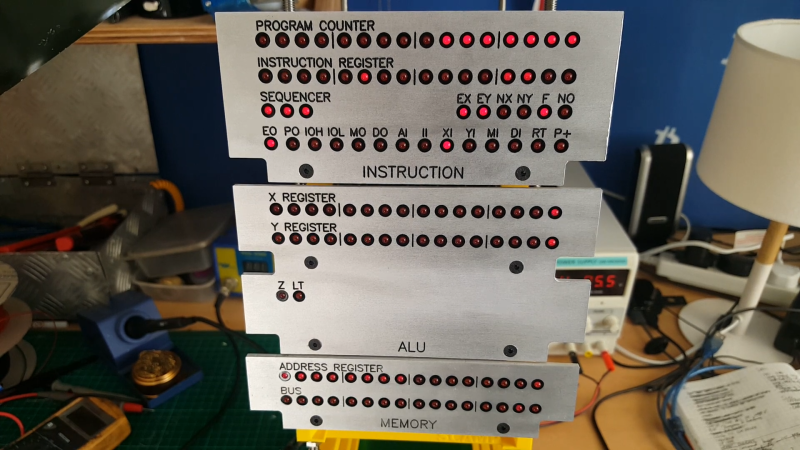Building your own computer has many possible paths. One can fabricate their own Z80 or MOS 6502 computers and then run a period correct OS. Or a person could start from scratch as [James Stanley] did. [James] has invented a completely unique computer and CPU he calls SCAMP. SCAMP runs a custom OS called SCAMP/os which you can check out in the video below the break.
[James] describes the CPU and computer as purposefully primitive. Built out of discrete 74xx series logic chips, it runs at a fast-enough-for-homebrew 1 MHz. Plus, it has a lot of blinking lights that can’t help but remind us of the original Imsai 8080. But instead of a panel of switches for programming, the SCAMP/os boots to a shell, which is presented through a serial terminal. Programs are written in a bespoke language with its own compiler. The OS is described as a having a Unix-like feel with CP/M-like functionality. That’s quite a combination!
What we love most about the build, other than its clean looks and blinkenlights, is the amount of work that [James] has put into documenting the build both on his blog and on Github, where the source code and design is available. There’s also an open invitation for contributors to help advance the project. We’re sure he’ll get there, one bit at a time.
While [James] is using a Compact Flash card for storage currently we can’t help but wonder if a Cassette Tape storage system might be a worthwhile future upgrade.
















Cheeky scamp!
https://en.m.wikipedia.org/wiki/National_Semiconductor_SC/MP
There was a historic computer called that sc/mp and another called the mini-scamp both based on the sc/mp processor.
And Elektor published a build-your-own project in the early 80’s(?) called SCAMP based on SC/MP.
6502 was created by MOS, not Motorola.
Whoops! Brain fade. Thanks for the correction. Updated.
Well, that is a point the folks at Motorola would not have conceded, back in the day.
Actually “MOS Technology”, thiugh often peoole confused it with Mostek.
And if we’re nitpicking, what does “original Imsai 8080” mean? It looks more like the Imsai? Or should it be Altair?
This is not a hack, this is complete insanity. Fantastic.
Will it run Crysis?
Just kidding… this is a fabulous undertaking! Akin to that guy that managed to run Ubuntu on an ATMega1284p: https://hackaday.com/2012/03/28/building-the-worst-linux-pc-ever/.
when power crisis or war crisis … meybe
Followed the link, not disappointed!
I found it interesting that so many of the names used by the commenters are no longer used.
Are they now longer with us? I did recognize Hirudinea (sp?), and someone going by the name of “Ren”.
Will it run Crysis?
Just kidding, this is a magnificent project! Reminds me of that guy who managed to run Ubuntu on an ATMega1284p.
Ice Studio and a TTL library ?, this I have to try !
Enough blinky lights to be included on the set of a sci-fi tv show! :)
Very impressive. Leaves me wondering what this fellow does for his day job.
Color me “Impressed!”
What an incredible project! The fact that he has a compiler for a custom language, targeting custom arch, that can compile itself, is absolutely amazing!
You spelt his name wrong.
“spelt”
Are we going to go through all that again?
B^)
Sorry, couldn’t help it. It’s my blood. It’s Type O. Yes, I’m positive.
Nice work, and I like the detail in the documents.
SCAMP was an IBM machine from I think the 1970s, and NAtional semi had a chip called SC/MP in the 70s which we called scamp.
Looking at it reminds me of the DEC PDP-10, only arranged vertically instead of horizontally. The ’10 had 6′ high cabinets roughly equivalent to the modules here, and at the top of each cabinet, whether it needed it or not, was a panel full of blinkenlights. Only the lights were tungsten. Hey! Note to self: on next blinkenlights panel, use “tungsten white” LEDs.
For space reasons I really need to to get away from building every interesting thing as real hardware. If someone ins interested in such systems in FPGA(s) (I’ve Lattice HX8k and UP5K at hand, but I’d use others with a FOSS toolchain too), I’d be all in. I’m dreaming of something like MiSTER focussed on non gaming retro systems and homegrown CPU stuff. For more complex systems even with multiple FPGAs on bus systems to stay flexible and easily expandable even over the limits/sizes of today’s hobby FPGA chips?